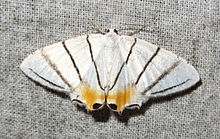| Epiplema | |
|---|---|

| |
| Epiplema himala | |
|
Scientific classification
| |
| Domain: | Eukaryota |
| Kingdom: | Animalia |
| Phylum: | Arthropoda |
| Class: | Insecta |
| Order: | Lepidoptera |
| Family: | Uraniidae |
| Subfamily: | Epipleminae |
| Genus: |
Epiplema Herrich-Schäffer, [1855] |
| Synonyms | |
| |
Epiplema is a genus of moths in the family Uraniidae described by Gottlieb August Wilhelm Herrich-Schäffer in 1855. A number of species have been reassigned to Europlema.
Description
Palpi porrect (extending forward), projecting beyond the frons. Forewings with vein 5 from the upper angle of cell and veins 6, 7 and 8, 9 stalked. Vein 10 usually from cell, rarely stalked with 8 and 9. Hindwings with veins 3 and 4 from angle of cell. Vein 5 from middle of discocellulars and veins 6 and 7 from upper angle. Wings held more or less apart in repose. [1]
Species
- Epiplema acutangularia Herrich-Schäffer, [1855]
- Epiplema albida
- Epiplema angulata Warren, 1896
- Epiplema argillodes Turner, 1903
- Epiplema certaria (Walker, 1861)
- Epiplema clathrata Warren, 1896
- Epiplema coeruleotincta Warren, 1896
- Epiplema exornata (Eversmann, 1837)
- Epiplema himala (Butler, 1880)
- Epiplema horrida (Warren, 1896)
- Epiplema incolorata (Guenée, 1857)
- Epiplema irrorata (Moore, 1887)
- Epiplema latifasciata (Moore, 1887)
- Epiplema leucosema Turner, 1911
- Epiplema quadristrigata (Walker, 1866)
- Epiplema saccata (Holloway, 1998)
- Epiplema stereogramma (Turner, 1903)
- Epiplema tenebrosa Hampson
- Epiplema thiocosma Turner, 1911
References
- ^ Hampson, G. F. (1895). The Fauna of British India, Including Ceylon and Burma: Moths Volume III. Taylor and Francis – via Biodiversity Heritage Library.
- Savela, Markku. "Epiplema Herrich-Schäffer, [1855]". Lepidoptera and Some Other Life Forms. Retrieved July 26, 2018.
| Epiplema | |
|---|---|

| |
| Epiplema himala | |
|
Scientific classification
| |
| Domain: | Eukaryota |
| Kingdom: | Animalia |
| Phylum: | Arthropoda |
| Class: | Insecta |
| Order: | Lepidoptera |
| Family: | Uraniidae |
| Subfamily: | Epipleminae |
| Genus: |
Epiplema Herrich-Schäffer, [1855] |
| Synonyms | |
| |
Epiplema is a genus of moths in the family Uraniidae described by Gottlieb August Wilhelm Herrich-Schäffer in 1855. A number of species have been reassigned to Europlema.
Description
Palpi porrect (extending forward), projecting beyond the frons. Forewings with vein 5 from the upper angle of cell and veins 6, 7 and 8, 9 stalked. Vein 10 usually from cell, rarely stalked with 8 and 9. Hindwings with veins 3 and 4 from angle of cell. Vein 5 from middle of discocellulars and veins 6 and 7 from upper angle. Wings held more or less apart in repose. [1]
Species
- Epiplema acutangularia Herrich-Schäffer, [1855]
- Epiplema albida
- Epiplema angulata Warren, 1896
- Epiplema argillodes Turner, 1903
- Epiplema certaria (Walker, 1861)
- Epiplema clathrata Warren, 1896
- Epiplema coeruleotincta Warren, 1896
- Epiplema exornata (Eversmann, 1837)
- Epiplema himala (Butler, 1880)
- Epiplema horrida (Warren, 1896)
- Epiplema incolorata (Guenée, 1857)
- Epiplema irrorata (Moore, 1887)
- Epiplema latifasciata (Moore, 1887)
- Epiplema leucosema Turner, 1911
- Epiplema quadristrigata (Walker, 1866)
- Epiplema saccata (Holloway, 1998)
- Epiplema stereogramma (Turner, 1903)
- Epiplema tenebrosa Hampson
- Epiplema thiocosma Turner, 1911
References
- ^ Hampson, G. F. (1895). The Fauna of British India, Including Ceylon and Burma: Moths Volume III. Taylor and Francis – via Biodiversity Heritage Library.
- Savela, Markku. "Epiplema Herrich-Schäffer, [1855]". Lepidoptera and Some Other Life Forms. Retrieved July 26, 2018.